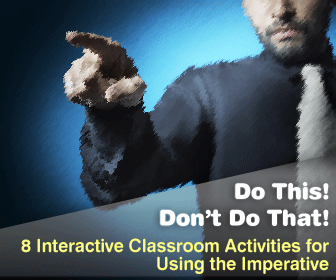How to Teach the Imperative Form


The imperative is probably best considered a mood rather than a tense in English, since it does not signal when any given action is performed. But even though it is not a tense in the traditional sense of the word for ESL students, understanding the imperative is important. They will encounter the imperative in English when giving or receiving instructions, commands or calls to action. When giving or receiving advice, your students will also need to use and/or understand the imperative. Here are some fun ways you can bring the imperative into your classroom that are creative, too. Have fun with the mood and you will find that your students and you will be in a good one.

Recipes are a great example of the imperative mood in authentic English text. The step-by-step directions for creating a culinary masterpiece, or at least lunch, are written in the imperative. In the case with recipes, the writer is giving a set of instructions to the reader with the hope that the reader will be able to reproduce the same results in his or her kitchen. Start your imperative cooking lesson by giving your students some recipes to look over. You will want to match the complexity and content of the recipe to your students’ language level. Copies from cookbooks or printouts online are great, but do not overlook simple instructions that come with a food product, like cooking directions on how to make pasta or rice. Point out to your students that the instructions in the recipe use the imperative mood and that the verbs take the second person present conjugation on a sample recipe. Then have your students find examples of imperative verbs in their own recipes. You may want to make a list of all the verbs your students find and review their definitions, especially cooking specific verbs, as a class.
If you have the classroom resources, or your students have adequate resources at home, give them a recipe to follow. If possible, have the ingredients for a no-cook recipe on hand, and have your students follow the directions in class. Myrecipes.com has tons of great ideas for no-cook recipes from the very simple to the very complex! Either individually or with a partner, have your students follow the directions for the culinary delight. (Be aware of any allergies your students may have and plan accordingly.) If your students follow their directions correctly, they should end up with something that looks very similar to the finished product shown in the recipe, and it should taste good, too. Celebrate your students’ accomplishments by having a social time and sharing each group’s creation!
Now that your students have followed directions given to them in the imperative, have them write their own imperative instructions for making a favorite food. Ask your students to write instructions for an item that they know how to cook. It might be a dish from their native culture or something local and more familiar to everyone in class. Even small children can do this activity though they may not actually know how to cook. Their instructions will be charming and even funny and might be worth posting on a bulletin board in class.
Besides written recipes, many cooking demonstrations use the imperative to communicate with their viewers how to make a particular dish. There are hundreds of cooking demos available on YouTube, so choose one that your students may like and show it to the class. Point out that as the actor/chef makes the recipe, he or she is giving instructions with the imperative mood to the viewer. Watch the video again and challenge your students to make note of any imperative verbs the chef uses. Follow by having your students do their own cooking demo in front of the class. You can request a serious tone and perhaps even ask your students to bring the food in and make the dish in class. Alternately, you may want your students to take a lighthearted approach and demonstrate how to make a fictional dish with real or fictional ingredients they might find in the classroom. Either way, your students will be putting the imperative to good use as they speak in front of your class. For fun, end your lesson with one or more videos of the famous Muppet the Swedish Chef. His comical kitchen exploits will elicit laughter no matter what native language your students speak!
Your students have other options when it comes to following directions and practicing the imperative. For beginning students or just for a change of pace, play a game of Simon Says. Start by leading yourself, but once your students have a feel for the game let them take turns being Simon. They will get the chance to practice using the imperative and the rest of the class will get to practice following the directions Simon gives.
Another great option for following directions is putting together a model. Kits are great, containing complete sets of instructions and materials, but they can be expensive. As an alternative, try supplying your class with a collection of building blocks and give them a set of directions for building various items. You can find thousands of directions on Lets Build It Again. Have your students choose the item they would like to build or just make a few sets of directions available in class and let them get to their constructions. Your students will have fun with their building block creations, and they will not even realize they are practicing the imperative in the process!
Your students will also need to use and understand the imperative mood when giving advice. Give your class a chance to share about something they are good at and give advice to classmates who might be trying that activity for the first time. Give each person five minutes in front of the class to explain how to do something that they know how to do. It may be something recreational like skateboarding or something professional like examining a specimen under a microscope or even something silly like how to become a superhero. Ask each person to give advice to a person who may just be starting out learning the activity. What should he do? What should he not do? Allow your students to ask questions after each presentation.
Advice giving can be creative, too. Role play a call in radio show where the host gives advice to the caller. To set the scene, show your students a small clip from the television show Frasier. Then recreate the scene in your classroom. Instead of showing the whole clip, you could show part of the television clip where the caller presents his problem, and then pause the video. Ask your students to offer advice using the imperative. Take several answers from your students before playing the rest of the clip and seeing what Frasier actually says.
Once you have found that, look online for instructions or directions or make some yourself for an activity related to that interest. Your students will have fun engaging in the activities and you will get the satisfaction of a lesson well taught.
What topics have you used to teach your students the imperative?